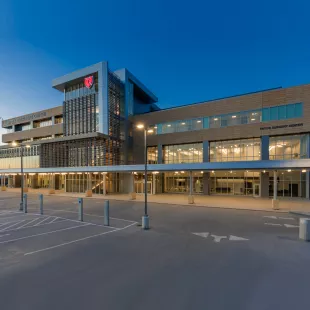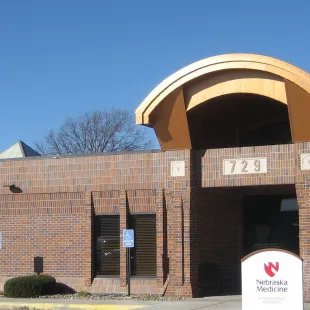Cerebrovascular (or Neurovascular) disease refers to a group of conditions that affect the circulation of blood to the brain, causing limited or no blood flow to affected areas. These conditions are typically very serious and can even be deadly.
Nebraska Medicine offers comprehensive endovascular and cerebrovascular treatment by highly trained and skilled surgeons to provide you the best outcome possible.
We provide treatment for:
- Atherosclerosis
- Arteriovenous Malformations
- Brain Aneurysm
- Carotid Stenosis
- Cavernous Malformation
- Carotid Dissections
- Cerebral Thrombosis
- Stroke
Why come to Nebraska Medicine for aneurysms and other cerebrovascular conditions
Highly-Trained Specialists
Nebraska Medicine is the only facility in the area with three fellowship-trained endovascular neurosurgeons on staff.
Endovascular surgeons have special training in endovascular surgeries, which are innovative, less invasive procedures used to treat problems affecting the blood vessels.
One of these surgeons also has fellowship training in open cerebrovascular surgery.
All three of these surgeons have had special training in performing mechanical thrombectomy, a new procedure for treating the most severe form of stroke -- ischemic stroke. This procedure can significantly improve outcomes for some types of stroke patients.
Minimally Invasive Options for Treating Aneurysms
An aneurysm is a protrusion in the wall of a blood vessel that can form in any artery, including in your brain. Most aneurysms occur in the aorta - the body's largest artery, which travels from your heart down the center of your chest and abdomen. Small aneurysms can often be left alone, but treatment should be considered for larger aneurysms. A ruptured aneurysm can quickly become life-threatening and requires prompt medical attention.
Brain Aneurysms
We offer two options for treating brain aneurysms -- the traditional surgical clipping which involves removing a small section of the skull to locate and exclude cerebral aneurysms. Our endovascular surgeons also offer a minimally invasive approach called endovascular coiling.
Surgical Clipping
To access the aneurysm, the neurosurgeon first removes a small section of the skull in a procedure called a craniotomy. Once the aneurysm is located, a tiny clip is placed across the neck of the aneurysm to isolate it from normal circulation. The clip is similar to a coil-spring clothespin, in that the clip blades remain closed until pressure is applied to open the clip. Once the clip is secured to the aneurysm, the surgeon secures the bone to its original location and closes the incision. The metallic clips remain on the aneurysm permanently.
Endovascular Coiling
Endovascular coiling is a minimally invasive approach that does not include open surgery. Instead, the Neuroendovascular surgeon uses fluoroscopic imaging, a type of real-time X-ray technology, to view the patient's vascular system and place coils within the aneurysm from within the blood vessel.
Endovascular treatment of brain aneurysms involves insertion of a catheter into the femoral artery in the groin and navigating it through the vascular system into the head and into the aneurysm. Tiny platinum coils are threaded through the catheter to fill the aneurysm, blocking blood flow into the aneurysm and preventing rupture. This endovascular coiling (filling) of the aneurysm is called embolization.
Minimally Invasive Techniques for Other Cerebrovascular Conditions
Carotid Stenosis
Carotid stenosis is a narrowing of the carotid artery due to the buildup of plaque and can lead to stroke.
Our endovascular surgeons offer several minimally invasive procedures for treating this condition.
Traditional treatment is performed through a procedure called carotid endarterectomy in which a surgeon makes an incision in the neck and opens the artery to remove the plaque.
Carotid artery angioplasty and stenting is performed with local anesthesia and involves placing a balloon-tipped catheter into the obstructed area of the artery and inflating it to compress the plaque against the artery walls. A stent is usually left in the artery to prevent recurrent narrowing.
Vascular Tumors
Our endovascular surgeons perform a procedure called tumor embolization to block the flow of blood vessels to very vascular tumors. The procedure is performed prior to the surgery to remove the tumor, potentially resulting in a safer, more efficient surgery. They can also perform embolization if you should have uncontrollable bleeding in the head and neck or if you have intractable and life-threatening cases of epistaxis/nosebleed.
Arteriovenous Malformations
Arteriovenous malformations (AVMs) are an uncommon developmental problem of the intracranial vasculature, which arise embryologically but usually do not progress into the symptomatic phase until the third or fourth decade of life. AVMs are tangled masses of vessels connecting arteries to veins without an intervening capillary bed region.
Treatment of an arteriovenous malformation depends on its size, location and angioarchitecture. The goal of AVM treatment is to eliminate the threat of intracranial hemorrhage, while striving to preserve neurologic function and minimize complications. The decision to treat a patient with an AVM requires balancing the natural history of the disease, particularly the risk of hemorrhage, against the risk of surgery.
Our Locations
-

Ear, Nose, Throat (ENT), Allergy and Audiology at Lauritzen Outpatient Center
4014 Leavenworth St.
Get Directions
Omaha, NE 68105 -

-

Vascular Surgery Clinic at Columbus Community Hospital
4600 38th St
Get Directions
Columbus, NE 68601
-
Awards & Recognition for Neurological Care
Learn more about our awards and recognitions for Neurological Care.
View More